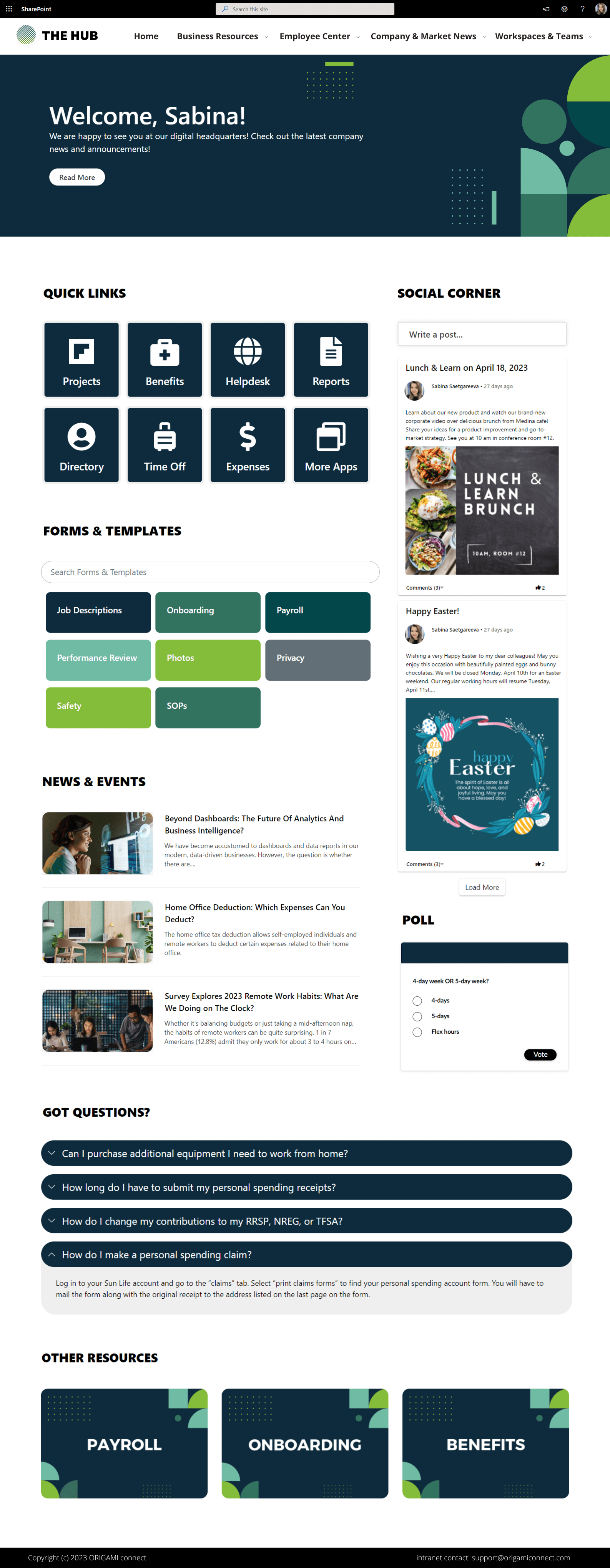According to the Nielsen Norman study of the return on investment for usability, demonstrate that the "usability" costs were between 8% and 13% of the projects' budget. Based on Origami customer research, 90% of respondents agree that user experience design phase in their intranet design has significantly improved project results. Even though the numbers point towards a growth in the amount of resources spent on user experience and design, there are still many organizations wondering how they can articulate the value to their project sponsors. In this post, I'll share what we measure to articulate the benefits of the usability design stage.
What Do We Measure to Calculate Intranet ROI?
In a webinar I had a chance to present on just a few weeks ago we did a poll. These are the priorities of two groups of leaders that were present during the call.
If you’re in IT, user satisfaction is important, any IT leader will tell you this because you’re are all well too familiar with how difficult it is to get a budget for a project if you can’t provide satisfied users.
For Communications, high engagement means better reach, without good engagement – you have limited reach, you can’t communicate effectively. And any business without a clear communication starts having bottlenecks and starts developing siloes.
Engagement
Now, then what is a good engagement – 100%, 90%, 60%. Anybody?
Hopefully not 15%. Sometime I hear leaders say, “well we should aim for 100% engagement”.
Instead of approaching this subject by anecdotes, when working with customers we wanted to measure what is the real usage of intranets out there. So we asked 10 companies to participate.
And we asked these 10 companies to let us measure how many users access their intranet since the launch to 6 months after the launch.
Here is what we found:
Now you see how some companies maintain over 85% while others drop off rightaway. So we started looking into common factors and patterns that kept occurring among these highly successful intranets.
Turns out the common factor among all of the highly adopted intranets had to do with measuring user feedback and adapting to that feedback.
Now to learn all about how to get that 85% user engagement you can check out this webinar.
How Do We Calculate Intranet ROI?
Now, sometimes companies assume that measuring feedback means sending surveys to all users and ask them what they want. And, you know some companies have done that. And the outcome they get varies.
User feedback is often very conflicting, so who do you listen to?
Now, before we dismiss the idea of sending surveys, let’s be realistic, comments that users leave in surveys are all valid, none of this is untrue. But usually they are too general to make any decision and if you make one, there is a high chance someone will disagree. And we’ve seen our customers get decision anxiety because it feels like they’re stuck between the rock and a hard place.
We chose the combination of qualitative and quantitative methods to do this research. This allows to measure not only whether the process was helpful but exactly how we can improve the intranet.
What we usually do is before your intranet is even online, we send users a simple interactive sitemap survey and we ask them to find a series things in that sitemap, usually 10-to 15 things. There is no right or wrong answers as far as users are concerned but on a background we collect user behaviors.
The summary will visually show you how many of your employees have been looking for content in a place different from where you decided to put that content. Red means, percentage of employees went to look in a wrong place.
This webinar shows exactly what kind of visualizations you get which includes heatmaps, scroll maps, and click maps.
Cost of underutilized SharePoint licences
Now, many of the IT executives we work with care about the software licences they have purchased. Of course, software not well adopted means that the licences you’re paying for every month are not fully utilized.
Let’s see how does this translate into dollars.
Say you have 1000 people in your organization, if out of these 1000 people, only 300 access your intranet for more than 2 minutes a day, does it mean it’s successful? Probably not, because that’s 30 % of available user population, right? Now, what if 80% of users access it? Is that better?
This calculator below was created to help some of our customers to quantify how engagement can lead to loss in licence utilization. It’s based on our study where we measured 10 intranet usage rates to find that some intranets are used by as little as 35% of employees.
If organization of a 1,000 employees, pays $30 for SharePoint Online, and only 40% of employees are using it daily - that adds up to $15,000 lost in licence overpayment.
When to Measure SharePoint Intranet Design ROI
During the design
When we design the site, and before your intranet is even online, we send users a simple interactive sitemap survey and we ask them to find a series things in that sitemap.
Sometimes I get asked how much time does it take to run these surveys and measure the bahavior. On average, it only takes about 8 minutes per user and you don’t have to send it everybody – we measured that 10% of company employees will give an accurate snapshot. This will make sure your intranet will launch on time with solid results and your employees will find it more intuitive.
After the launch
I’ve spoken to Communications Managers from all over the world and they biggest issue is that often they just shoot in a dark. They don’t know what users are reading, how do they interact with the article, do they skim, or do they just read the title.
Let’s be honest not only it’s hard to improve when you get no feedback, it’s also very frustrating, and draining!
So how do we get feedback beyond just page views. We have to know what’s going on when employees are using your intranet. What are the most popular links they click on, how far down the page they scroll, are they reading or skimming.
All these are measured after your intranet launches.
In Summary
I’m personally fascinated by the amount of accurate data we get from running analytics studies with customers. It helps the project be more successful and demonstrate the ROI to the leadership.
Articulating ROI of your intranet design is key to bringing attention to why the project was successful and taking into account feedback from your key stakeholders. By being able to show what went well and demonstrate clear improvement will get the budget and, let’s be honest, make your job much more rewarding knowing that you help your employees and not have to shoot in the dark.
If you’re as fascinated by the power of ROI on an intranet project as I am, drop us a note here and I’ll be in touch to discuss your specific needs.
Yaroslav Pentsarskyy is the Director of Product at Origami. He's also 8 time Microsoft MVP, speaker at many local and worldwide tech events, and a published author of several SharePoint related books.













See SharePoint intranet examples that will cut your research time and help you brainstorm ideas for a new Office 365 intranet.